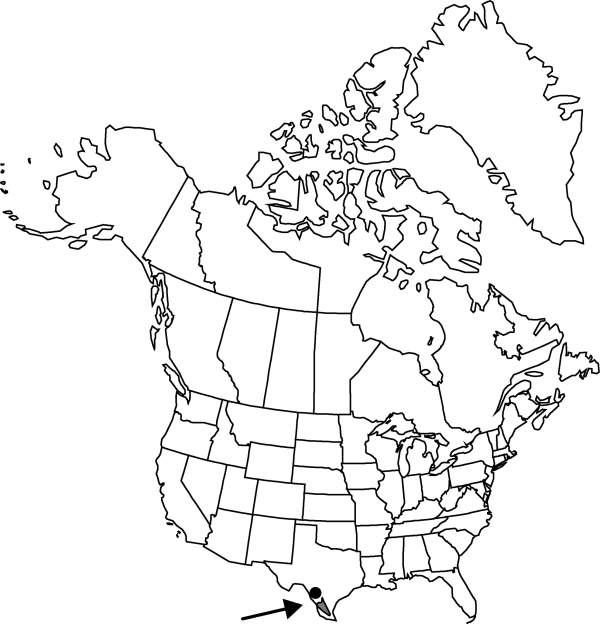Difference between revisions of "Echinocereus papillosus"
Cact.-Verz., 19. 1859.
FNA>Volume Importer |
imported>Volume Importer |
||
| Line 30: | Line 30: | ||
|phenology=Flowering early spring; fruiting 2 months after flowering. | |phenology=Flowering early spring; fruiting 2 months after flowering. | ||
|habitat=Open prairies with mesquite, Tamaulipan thorn scrub, alluvium, red gravel, limestone | |habitat=Open prairies with mesquite, Tamaulipan thorn scrub, alluvium, red gravel, limestone | ||
| − | |elevation= | + | |elevation=0–150 m |
|distribution=Tex.;Mexico (Nuevo León;Tamaulipas). | |distribution=Tex.;Mexico (Nuevo León;Tamaulipas). | ||
|discussion=<p>Small-stemmed plants were designated as <i>Echinocereus papillosus</i> var. angusticeps (Clover) W. T. Marshall, reportedly endemic near Linn, Texas. The status of the proposed variety remains unresolved but appears weak; W. Blum et al. (1998) and E. F. Anderson (2001) considered the name to be a synonym of typical <i>E. papillosus</i>.</p> | |discussion=<p>Small-stemmed plants were designated as <i>Echinocereus papillosus</i> var. angusticeps (Clover) W. T. Marshall, reportedly endemic near Linn, Texas. The status of the proposed variety remains unresolved but appears weak; W. Blum et al. (1998) and E. F. Anderson (2001) considered the name to be a synonym of typical <i>E. papillosus</i>.</p> | ||
| Line 49: | Line 49: | ||
|phenology=Flowering early spring; fruiting 2 months after flowering. | |phenology=Flowering early spring; fruiting 2 months after flowering. | ||
|habitat=Open prairies with mesquite, Tamaulipan thorn scrub, alluvium, red gravel, limestone | |habitat=Open prairies with mesquite, Tamaulipan thorn scrub, alluvium, red gravel, limestone | ||
| − | |elevation= | + | |elevation=0–150 m |
|distribution=Tex.;Mexico (Nuevo León;Tamaulipas). | |distribution=Tex.;Mexico (Nuevo León;Tamaulipas). | ||
|reference=None | |reference=None | ||
| Line 55: | Line 55: | ||
|publication year=1859 | |publication year=1859 | ||
|special status= | |special status= | ||
| − | |source xml=https:// | + | |source xml=https://bibilujan@bitbucket.org/aafc-mbb/fna-data-curation.git/src/bb6b7e3a7de7d3b7888a1ad48c7fd8f5c722d8d6/coarse_grained_fna_xml/V4/V4_311.xml |
|subfamily=Cactaceae subfam. Cactoideae | |subfamily=Cactaceae subfam. Cactoideae | ||
|genus=Echinocereus | |genus=Echinocereus | ||
Revision as of 23:14, 27 May 2020
Plants irregularly forming clumps at or before flowering. Stems mostly nearly erect when young, frequently decumbent in old age, cylindric, 4–15 × 2–3(–7) cm; ribs (6–)7–10, crests strongly undulate; areoles 10–15 mm apart. Spines 8–12 per areole, straight, appressed-spreading (radial spines) or projecting to appressed (central spines), white, yellow, or brown and white; radial spines 7–10 per areole, to 15 mm; central spines 1(–4) per areole, brown, terete, to 25 mm. Flowers funnelform, 7–9 × 7–12 cm; flower tube 20–30 × 10–30 mm; flower tube hairs 1 mm; inner tepals yellow, proximally orange-red to purple, 15–40 × 10–20 mm, tips relatively thin and delicate; filaments yellowish to orange-red; anthers yellow; nectar chamber 4–6 mm. Fruits green, 15–25 mm, pulp white. 2n = 22.
Phenology: Flowering early spring; fruiting 2 months after flowering.
Habitat: Open prairies with mesquite, Tamaulipan thorn scrub, alluvium, red gravel, limestone
Elevation: 0–150 m
Distribution

Tex., Mexico (Nuevo León, Tamaulipas).
Discussion
Small-stemmed plants were designated as Echinocereus papillosus var. angusticeps (Clover) W. T. Marshall, reportedly endemic near Linn, Texas. The status of the proposed variety remains unresolved but appears weak; W. Blum et al. (1998) and E. F. Anderson (2001) considered the name to be a synonym of typical E. papillosus.
Selected References
None.